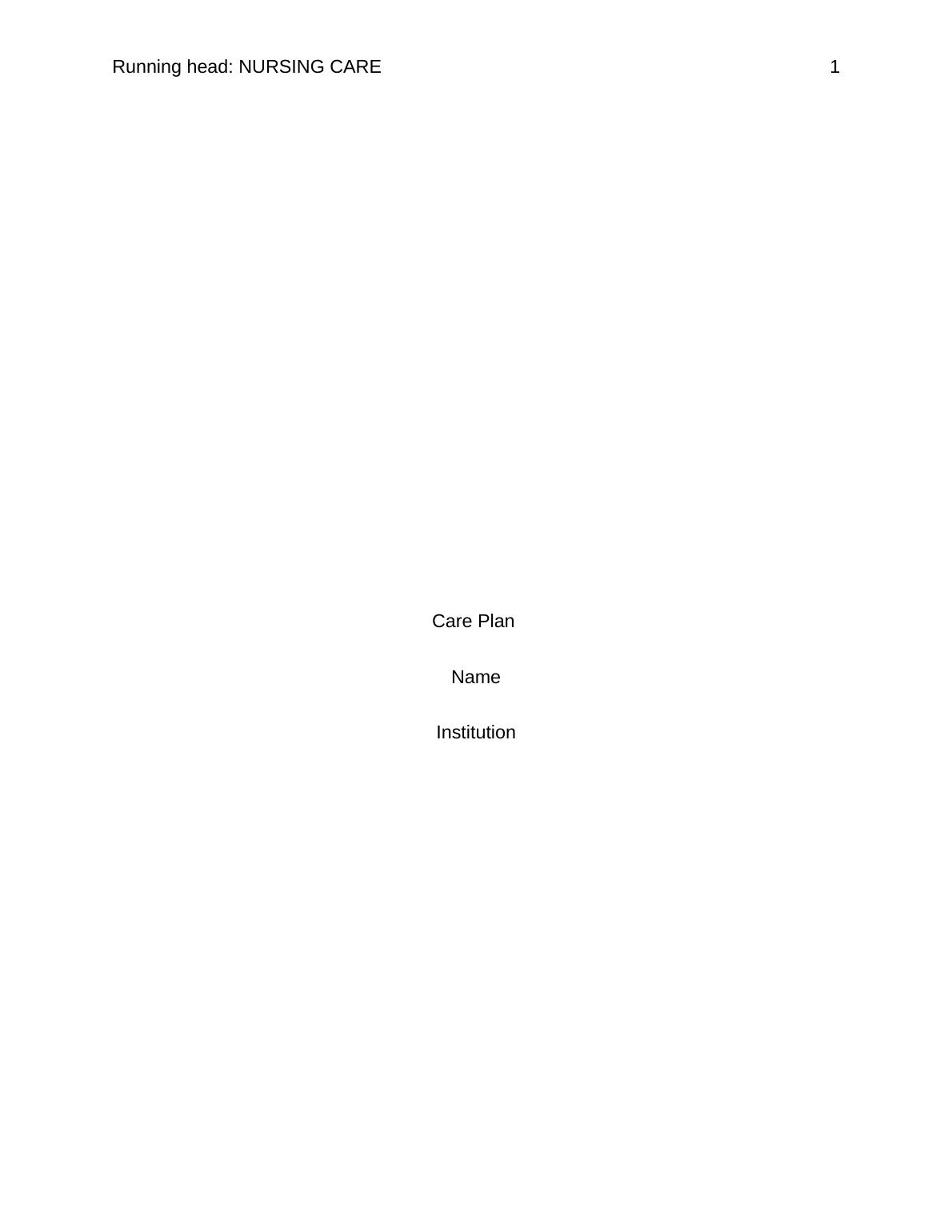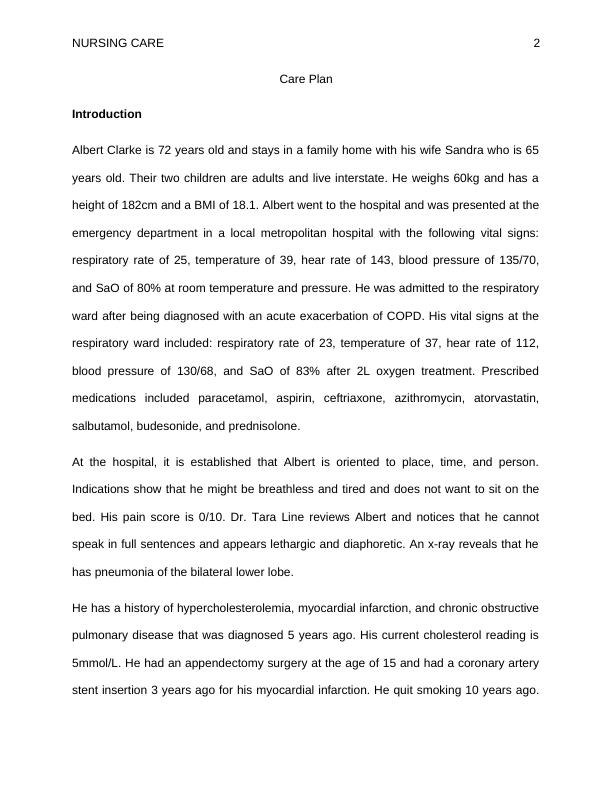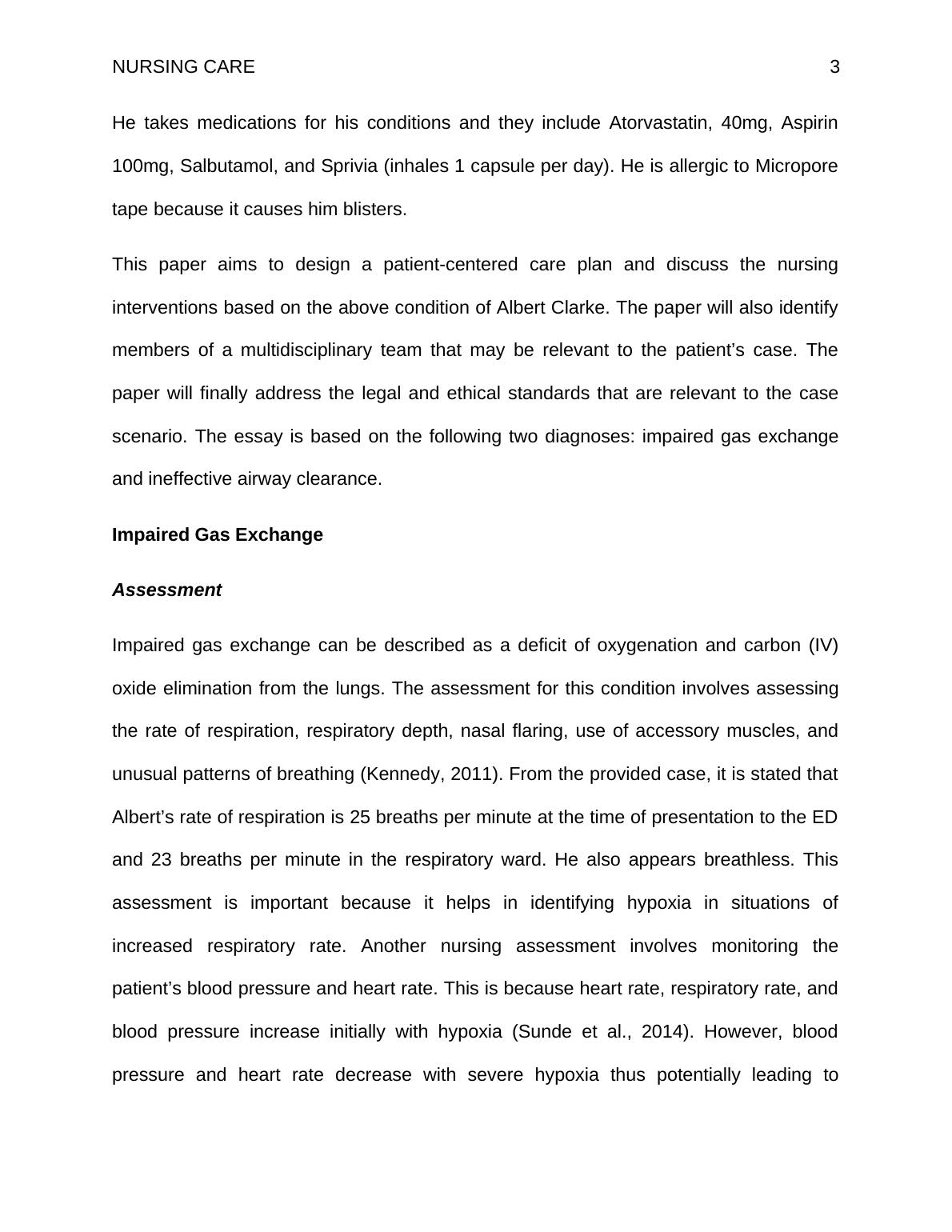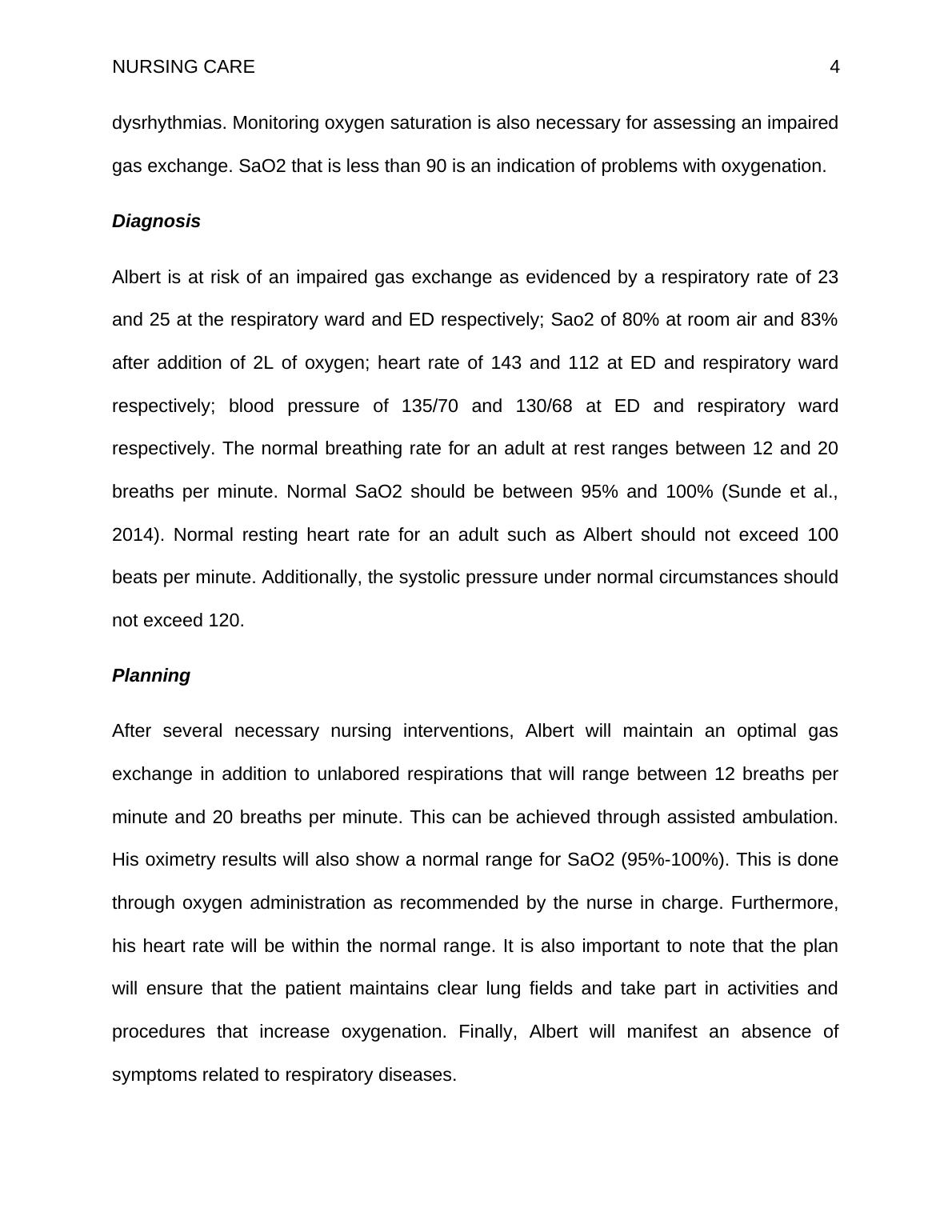A 72-year-old NURSING CARE 11 NURSING CARE 1 Care Plan Name Institution Care Plan Name Albert Clarke
Added on 2022-08-16
12 Pages2717 Words339 Views
Running head: NURSING CARE 1
Care Plan
Name
Institution
Care Plan
Name
Institution

NURSING CARE 2
Care Plan
Introduction
Albert Clarke is 72 years old and stays in a family home with his wife Sandra who is 65
years old. Their two children are adults and live interstate. He weighs 60kg and has a
height of 182cm and a BMI of 18.1. Albert went to the hospital and was presented at the
emergency department in a local metropolitan hospital with the following vital signs:
respiratory rate of 25, temperature of 39, hear rate of 143, blood pressure of 135/70,
and SaO of 80% at room temperature and pressure. He was admitted to the respiratory
ward after being diagnosed with an acute exacerbation of COPD. His vital signs at the
respiratory ward included: respiratory rate of 23, temperature of 37, hear rate of 112,
blood pressure of 130/68, and SaO of 83% after 2L oxygen treatment. Prescribed
medications included paracetamol, aspirin, ceftriaxone, azithromycin, atorvastatin,
salbutamol, budesonide, and prednisolone.
At the hospital, it is established that Albert is oriented to place, time, and person.
Indications show that he might be breathless and tired and does not want to sit on the
bed. His pain score is 0/10. Dr. Tara Line reviews Albert and notices that he cannot
speak in full sentences and appears lethargic and diaphoretic. An x-ray reveals that he
has pneumonia of the bilateral lower lobe.
He has a history of hypercholesterolemia, myocardial infarction, and chronic obstructive
pulmonary disease that was diagnosed 5 years ago. His current cholesterol reading is
5mmol/L. He had an appendectomy surgery at the age of 15 and had a coronary artery
stent insertion 3 years ago for his myocardial infarction. He quit smoking 10 years ago.
Care Plan
Introduction
Albert Clarke is 72 years old and stays in a family home with his wife Sandra who is 65
years old. Their two children are adults and live interstate. He weighs 60kg and has a
height of 182cm and a BMI of 18.1. Albert went to the hospital and was presented at the
emergency department in a local metropolitan hospital with the following vital signs:
respiratory rate of 25, temperature of 39, hear rate of 143, blood pressure of 135/70,
and SaO of 80% at room temperature and pressure. He was admitted to the respiratory
ward after being diagnosed with an acute exacerbation of COPD. His vital signs at the
respiratory ward included: respiratory rate of 23, temperature of 37, hear rate of 112,
blood pressure of 130/68, and SaO of 83% after 2L oxygen treatment. Prescribed
medications included paracetamol, aspirin, ceftriaxone, azithromycin, atorvastatin,
salbutamol, budesonide, and prednisolone.
At the hospital, it is established that Albert is oriented to place, time, and person.
Indications show that he might be breathless and tired and does not want to sit on the
bed. His pain score is 0/10. Dr. Tara Line reviews Albert and notices that he cannot
speak in full sentences and appears lethargic and diaphoretic. An x-ray reveals that he
has pneumonia of the bilateral lower lobe.
He has a history of hypercholesterolemia, myocardial infarction, and chronic obstructive
pulmonary disease that was diagnosed 5 years ago. His current cholesterol reading is
5mmol/L. He had an appendectomy surgery at the age of 15 and had a coronary artery
stent insertion 3 years ago for his myocardial infarction. He quit smoking 10 years ago.

NURSING CARE 3
He takes medications for his conditions and they include Atorvastatin, 40mg, Aspirin
100mg, Salbutamol, and Sprivia (inhales 1 capsule per day). He is allergic to Micropore
tape because it causes him blisters.
This paper aims to design a patient-centered care plan and discuss the nursing
interventions based on the above condition of Albert Clarke. The paper will also identify
members of a multidisciplinary team that may be relevant to the patient’s case. The
paper will finally address the legal and ethical standards that are relevant to the case
scenario. The essay is based on the following two diagnoses: impaired gas exchange
and ineffective airway clearance.
Impaired Gas Exchange
Assessment
Impaired gas exchange can be described as a deficit of oxygenation and carbon (IV)
oxide elimination from the lungs. The assessment for this condition involves assessing
the rate of respiration, respiratory depth, nasal flaring, use of accessory muscles, and
unusual patterns of breathing (Kennedy, 2011). From the provided case, it is stated that
Albert’s rate of respiration is 25 breaths per minute at the time of presentation to the ED
and 23 breaths per minute in the respiratory ward. He also appears breathless. This
assessment is important because it helps in identifying hypoxia in situations of
increased respiratory rate. Another nursing assessment involves monitoring the
patient’s blood pressure and heart rate. This is because heart rate, respiratory rate, and
blood pressure increase initially with hypoxia (Sunde et al., 2014). However, blood
pressure and heart rate decrease with severe hypoxia thus potentially leading to
He takes medications for his conditions and they include Atorvastatin, 40mg, Aspirin
100mg, Salbutamol, and Sprivia (inhales 1 capsule per day). He is allergic to Micropore
tape because it causes him blisters.
This paper aims to design a patient-centered care plan and discuss the nursing
interventions based on the above condition of Albert Clarke. The paper will also identify
members of a multidisciplinary team that may be relevant to the patient’s case. The
paper will finally address the legal and ethical standards that are relevant to the case
scenario. The essay is based on the following two diagnoses: impaired gas exchange
and ineffective airway clearance.
Impaired Gas Exchange
Assessment
Impaired gas exchange can be described as a deficit of oxygenation and carbon (IV)
oxide elimination from the lungs. The assessment for this condition involves assessing
the rate of respiration, respiratory depth, nasal flaring, use of accessory muscles, and
unusual patterns of breathing (Kennedy, 2011). From the provided case, it is stated that
Albert’s rate of respiration is 25 breaths per minute at the time of presentation to the ED
and 23 breaths per minute in the respiratory ward. He also appears breathless. This
assessment is important because it helps in identifying hypoxia in situations of
increased respiratory rate. Another nursing assessment involves monitoring the
patient’s blood pressure and heart rate. This is because heart rate, respiratory rate, and
blood pressure increase initially with hypoxia (Sunde et al., 2014). However, blood
pressure and heart rate decrease with severe hypoxia thus potentially leading to

NURSING CARE 4
dysrhythmias. Monitoring oxygen saturation is also necessary for assessing an impaired
gas exchange. SaO2 that is less than 90 is an indication of problems with oxygenation.
Diagnosis
Albert is at risk of an impaired gas exchange as evidenced by a respiratory rate of 23
and 25 at the respiratory ward and ED respectively; Sao2 of 80% at room air and 83%
after addition of 2L of oxygen; heart rate of 143 and 112 at ED and respiratory ward
respectively; blood pressure of 135/70 and 130/68 at ED and respiratory ward
respectively. The normal breathing rate for an adult at rest ranges between 12 and 20
breaths per minute. Normal SaO2 should be between 95% and 100% (Sunde et al.,
2014). Normal resting heart rate for an adult such as Albert should not exceed 100
beats per minute. Additionally, the systolic pressure under normal circumstances should
not exceed 120.
Planning
After several necessary nursing interventions, Albert will maintain an optimal gas
exchange in addition to unlabored respirations that will range between 12 breaths per
minute and 20 breaths per minute. This can be achieved through assisted ambulation.
His oximetry results will also show a normal range for SaO2 (95%-100%). This is done
through oxygen administration as recommended by the nurse in charge. Furthermore,
his heart rate will be within the normal range. It is also important to note that the plan
will ensure that the patient maintains clear lung fields and take part in activities and
procedures that increase oxygenation. Finally, Albert will manifest an absence of
symptoms related to respiratory diseases.
dysrhythmias. Monitoring oxygen saturation is also necessary for assessing an impaired
gas exchange. SaO2 that is less than 90 is an indication of problems with oxygenation.
Diagnosis
Albert is at risk of an impaired gas exchange as evidenced by a respiratory rate of 23
and 25 at the respiratory ward and ED respectively; Sao2 of 80% at room air and 83%
after addition of 2L of oxygen; heart rate of 143 and 112 at ED and respiratory ward
respectively; blood pressure of 135/70 and 130/68 at ED and respiratory ward
respectively. The normal breathing rate for an adult at rest ranges between 12 and 20
breaths per minute. Normal SaO2 should be between 95% and 100% (Sunde et al.,
2014). Normal resting heart rate for an adult such as Albert should not exceed 100
beats per minute. Additionally, the systolic pressure under normal circumstances should
not exceed 120.
Planning
After several necessary nursing interventions, Albert will maintain an optimal gas
exchange in addition to unlabored respirations that will range between 12 breaths per
minute and 20 breaths per minute. This can be achieved through assisted ambulation.
His oximetry results will also show a normal range for SaO2 (95%-100%). This is done
through oxygen administration as recommended by the nurse in charge. Furthermore,
his heart rate will be within the normal range. It is also important to note that the plan
will ensure that the patient maintains clear lung fields and take part in activities and
procedures that increase oxygenation. Finally, Albert will manifest an absence of
symptoms related to respiratory diseases.

End of preview
Want to access all the pages? Upload your documents or become a member.
Related Documents
Nursing Care plan Of A Patientlg...
|11
|2910
|22
CARE PLAN OF ALBERR CLARKElg...
|11
|2885
|23
NUR250 Assessment 1 S2 2018lg...
|14
|3193
|348
Development of a Person-centred Care Plan Assignment 2022lg...
|14
|3599
|24
Mr. Smith’s Case Studylg...
|7
|3062
|89
Nursing Care Plan for Myocardial Infarction Patientlg...
|13
|2234
|267
